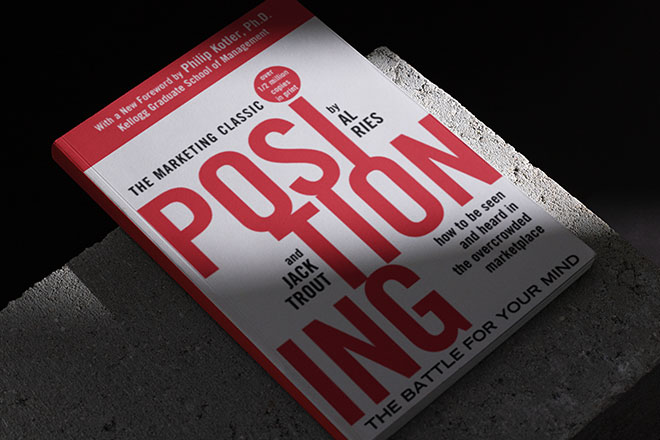It’s been 42 years since Al Ries and Jack Trout published their definitive marketing book, “Positioning: The Battle for Your Mind.” The seminal premise proffered by Rees and Trout was that in the age of over-communication, marketing is not a battle of products, it’s a battle of perceptions. If you’re in the process of identifying and establishing brand positioning for your organization, these seven rules will help guide you down the road toward success.
If you’re unfamiliar with positioning strategy, then you should first read Ries and Trout’s book. It’s imperative to understand the basic concept of differentiation before undertaking this initiative. Unlike mission and vision statements which serve as a mirror for internal audiences, positioning strategy is not a mirror. It’s a lens. A lens goes two ways. It focuses a company’s own strengths and weaknesses and those of its competitors.
The 7 Steps to Identifying and Establishing Brand Positioning
1. Start with the category.
Humans think of categories before brands. They need to know the “what” before they know the “why.” What is your product and what category does it inhabit? It’s human nature to categorize and sort. Only after we know what it is, do we decide why we will buy from one company or another.
For example, most people don’t decide to buy a particular brand of sofa. They first decide what category of sofa to buy: love seat, sectional, or recliner; expensive or economical; leather or fabric. Then they look into their minds to find what brand names they associate with their chosen category. For example, if it’s a recliner, there’s a high probability that La-Z-Boy will be on that list.
The category provides customers with the context they require to compare your brand with others that reside on the same “ladder” within the mind. Another example of a category is cars, and the ladders within that category include minivans, SUVs, crossovers, luxury cars, sports cars, pickup trucks, and of course, standard cars. Minivan brands, for example, might be Toyota Sienna or Honda Odyssey. For SUVs, the brand list changes to Ford Explorer, Nissan Pathfinder, and others. And for the pickup ladder, it might be the Ford F-150 or a Chevy Silverado. Psychologists suggest that the mind typically only holds 3-7 brand names on any given ladder and the goal is to be #1 or #2. If not, it might be time for something new.
This step is critically important because customers need to consider points of parity before considering points of differentiation (i.e., your position – what makes your product unique).
2. Be willing to sacrifice.
Intellectually, we know we can’t be all things to all people. Emotionally we tend to view sacrifice as bad, something to avoid. But sacrifice is your greatest friend when finding and focusing on a position.
One of the inherent benefits of identifying and establishing brand positioning is that it defines the target audience in precise terms. This means targeting only those customers who care a lot about what you do. Those who want whiter whites, buy Tide. And those who want a more professional launder, buy Persil. People who want to look successful buy Mercedes or BMW. Those on a budget, who are also concerned with the environment, buy a Chevy Bolt, not a Tesla.
The ROI value of marketing a Tesla to a Bolt customer? Zero. It costs more to focus resources on chasing the wrong customers than lavish resources on the right customer. In What is Strategy?, Michael Porter argues that trade-offs are essential to strategy. He goes on to say that strong leadership means avoiding the temptation of proclaiming excellence on all fronts. The willing sacrifices imposed by identifying and establishing brand positioning strengthen and protect your market position.
3. Make your position actual versus aspirational.
Without going into the finer details of the discipline we’ve developed to discover a position, one important warning is to identify your position as a very basic concept. Beware of making this your “big, hairy, audacious goal” (BHAG). A brand position is not a magical, mystical force designed to “elevate the world’s consciousness” (WeWork) or “promote unity and understanding” (Pepsi-Cola).
A position is a simple, pragmatic, and obvious idea. Consider these examples: sensitive teeth toothpaste (Sensodyne); the elevated coffee experience (Starbucks); ultimate performance apparel (Nike); reliable car (Toyota); affordable luxury car (Lexus – owned by Toyota, btw). All these concepts are basic ideas the mind doesn’t have to perform mental gymnastics to understand.
Additionally, a position should already be true to your brand. If your position doesn’t meet both conditions (basic and believable), it is not a good position.
4. Fit your strategy to the context.
It’s important to “contextualize” your idea to the market, the target customer, and trends. “One does not plan and then try to make the circumstances fit those plans,” said General George S. Patton. “One tries to make the plan fit the circumstances.” You want to make sure your positioning strategy makes sense in the market. Get an outside perspective to help guide and check your discussions. Innis Maggiore is the nation’s leading positioning ad agency, so we’re an obvious option for you to discuss your positioning concept.
5. Credential your position with channel and price.
Where you choose to sell your product, and at what price, has the effect of credentialing or de-credentialing your position. A low price on a high-performance product would understandably foster skepticism about quality. Channel ubiquity can undermine the mystique of a brand. Consider Starbucks coffee sold in Target stores. Or Krispy Kreme, an example of a brand that went from a served hot and fresh unique donut, to a grocery store commodity.
One good example, and a company that got it right, is Stihl, the German manufacturer of chain saws and other handheld power equipment. Its superior quality position is credentialed by its decision to sell exclusively through its authorized dealer network in the U.S. It boldly claims in its advertising that it does not sell through Lowe’s or Home Depot. Wise decision.
6. Make sure you can communicate your strategy, simply and clearly.
The best positioning strategies are simple, concise, emotionally stirring, and use language customers use. Then they are marketed with sufficient resources to win mindshare. Lysol, Listerine, and PURELL kill germs (in different categories). Coca-Cola is the original cola. Pepsi is the cola drink of a new generation. Dominos delivers pizza. Papa John’s pizza has better ingredients and therefore, better taste. Simple concepts, marketed with sufficient resources so you already know each of these brands’ positions.
These positions are not accidents of luck. Each represents an intentional strategy for dealing with competition and the human mind. The truth is, customers are annoyingly preoccupied and impervious to marketing messages. The more complex the idea, the harder it is to communicate. The harder it is to communicate, the greater the likelihood people will ignore it. If your positioning strategy can’t be understood by pretty much anyone, you might want to rethink your strategy.
7. Don’t DIY. Don’t outsource. Goldilocks it.
As said earlier, a positioning strategy is not a mirror. It’s a lens. And lenses go two ways. You should not develop your positioning strategy on your own, nor should you fully outsource.
If you develop it alone, you’re likely, like a mirror, to reflect existing biases or protect sacred cows. It’s too easy to underestimate competitors and disruptive market forces and over-estimate your own abilities and faculties.
The task cannot be totally outsourced either.
The outsider lacks crucial information about the company – its history, DNA, current markets, customers, and capabilities to render a position that would create buy-in within the organization. It is also easy to dismiss the outsourced feedback as “wrong” no matter how “right” it might be if it doesn't match what you want to see in the mirror.
The best answer is a Goldilocks decision: have your firm develop its positioning strategy in collaboration with a positioning expert such as Innis Maggiore. This way, you get an outside perspective with a strategy you can and will commit to as coming from within.
Our Appreciative Discovery® is structured to help YOU find or rediscover your position and gain buy-in from your C-suite, top management, and/or marketing and sales teams. Contact us today for help in identifying and establishing your brand positioning.



